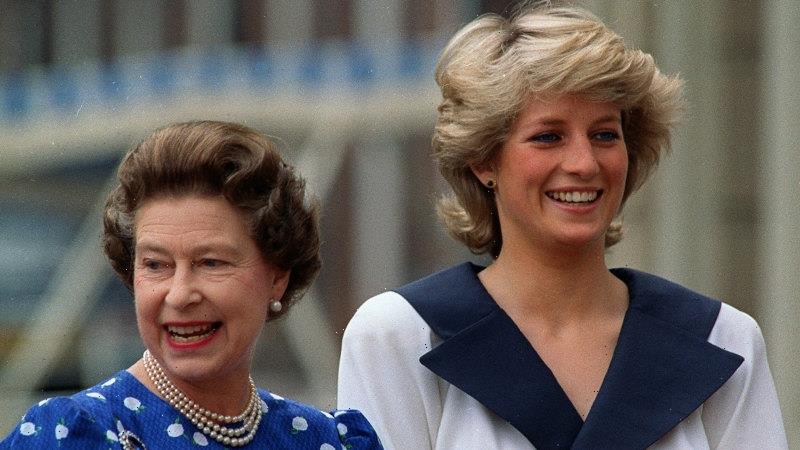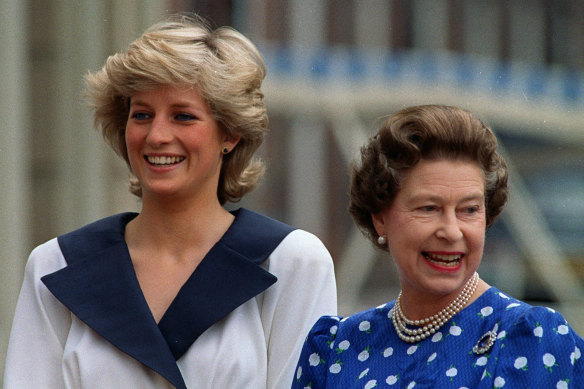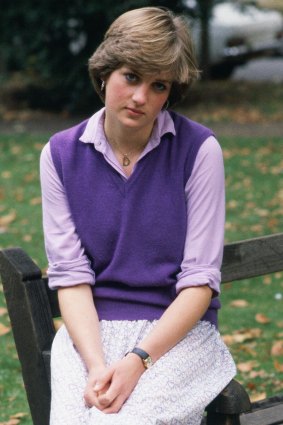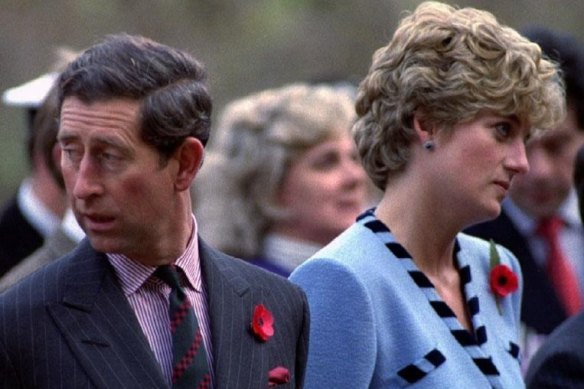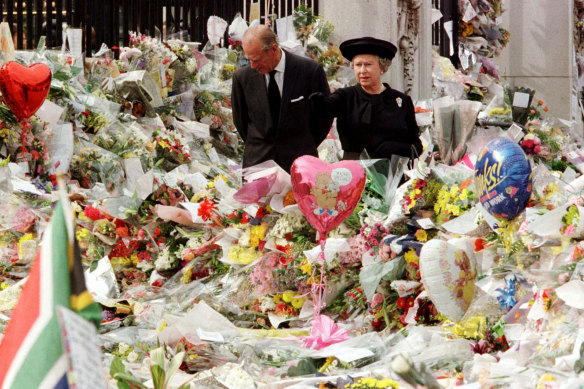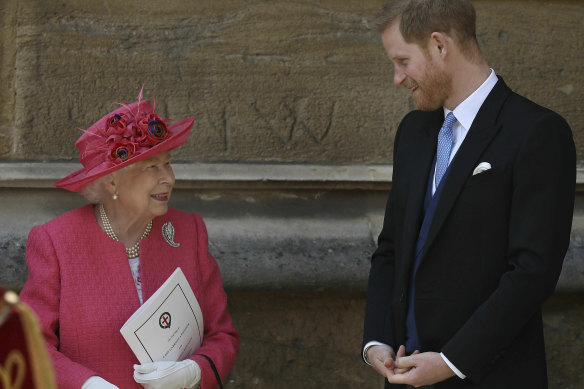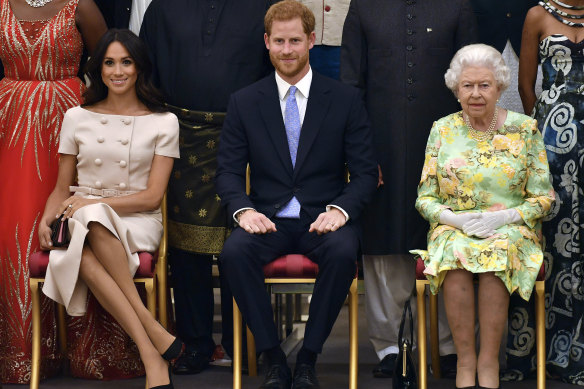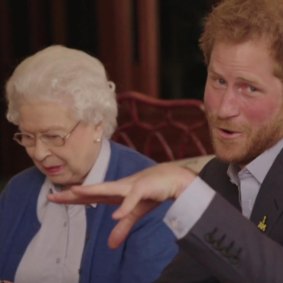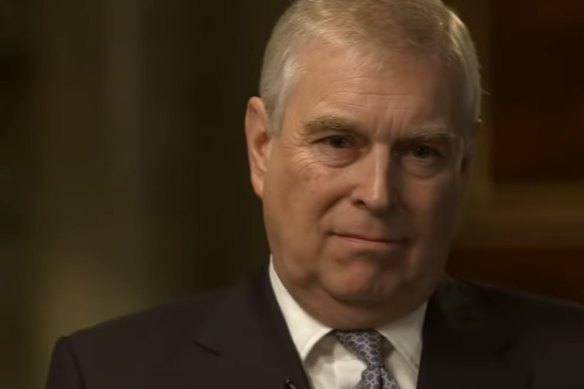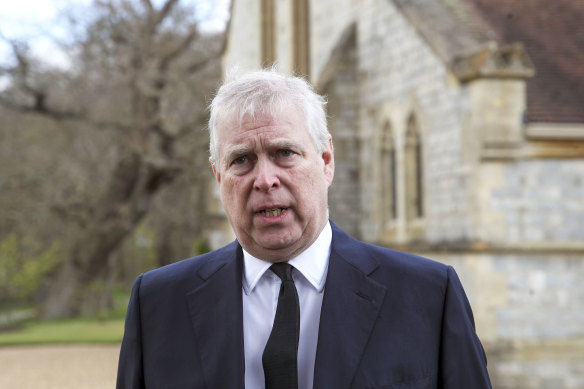Celebrating Prince Harry’s christening at Windsor in 1984, the royal family had a hoot. The baby’s grandmother, Queen Elizabeth, wore priceless sapphires and a huge smile as toddler Prince William entertained the rellies with an impromptu dance. The two-year-old’s capering made Harry’s godfather, Prince Andrew, roar with laughter, and Princess Diana, her second son in her arms in a frothy heirloom gown, looked relaxed and happy.
At that moment in history, the house of Windsor was on an even keel. Ahead for the Queen lay her “annus horribilis” in 1992, the disintegration of marriages and fairytales, and the death of her beloved husband. In the ensuing decades, the monarch’s expert diplomatic treading of the fine line between The Firm and the family would be tested by three of the major players at the joyous christening—Diana, Andrew and Harry.
The royals gather for Prince Harry’s christening in 1984. Seated from left: Lady Fermoy (Diana’s grandmother), the Queen Mother, The Queen, Prince William (fore), the Princess of Wales with Prince Harry, the Prince of Wales and Mrs Shand-Kydd (Diana’s mother). Standing from left: Lady Sarah Armstrong-Jones, Bryan Organ, Gerald Ward, Prince Andrew, Prince Philip, Lord Spencer, Lady Cece Vestey and Mrs William Bartholomew (ex Carolyn Pride).Credit:Syndication International.
The trio of senior royals broke the mould and reportedly almost broke the Queen’s heart. Diana lost her rank and her life. Linked to paedophiles and money and sex scandals, Andrew was outcast, stripped by his mother of his royal titles. Harry cut ties with the family to decamp to California and go into business with his controversial wife, Meghan Markle.
One of the great successes of the Queen’s reign was balancing her loyalty to the nation and to her own kin. Here’s how her equilibrium was tested most by those closest to her.
The Queen vs the Queen of People’s Hearts
When Vanity Fair’s February 1993 edition landed, there was cover girl Princess Diana in full glittery tiara mode, complete with Mona Lisa smile, kohl-rimmed eyes and a headline that promised fireworks, if not treason: ‘Di’s Palace Coup’.
Fresh from her separation from Prince Charles, Diana was planning not just a heavyweight future on the world stage but “plotting her revenge”, claimed the story. After a decade of “public triumph and private suffering”, she was transforming from clotheshorse to well-groomed workhorse as a “glamorous roving ambassador” for British exports, aid, culture and style.
The Princess of Wales and the Queen put on their best public faces outside Clarence House in 1987.Credit:Martin Cleaver.
She was viewed as a priceless asset for the Foreign Office, judged the glossy. A feminist who had struck a symbolic blow at the apex of the Establishment. A contemporary, dynamic career woman hellbent on making the world a better place.
One would love to know what the real Queen, not the queen of people’s hearts, made of it all – and if she wondered how and when things went so pear-shaped with the manipulative, charismatic outsider who wreaked havoc while making the royals more relevant, modern and popular than they’d been since the Queen was first crowned.
Just four years after the Vanity Fair piece, the Queen was remembering Diana to a global audience as “an exceptional human being”, after her untimely death in a 1997 Paris car crash: “She never lost her capacity to smile and laugh, nor to inspire others with her warmth and kindness.”
But what really lay between the public tribute and the private feelings of the Queen for her troubled, dazzling lost daughter-in-law? What was the true relationship between the two power-player Windsor women? Was Diana the Queen’s nemesis or her unlikely doppelganger, both united by devoting their lives to public service and their shared family?
The answer is it’s impossible to know. Through the mess of the Wales’ relationship – affairs on both sides, media wars, the dissolution of the marriage – the Queen, of course, never commented. Diana, however, dropped pointed vignettes she was not like the monarch: “I do things differently because I don’t go by a rule book, [and] because I lead from the heart, not the head.”
Early on, Diana was an asset to the Windsors – until she stole the show. Her star power impacted the Queen, according to Arianne Chernock, an associate professor of history at Boston University focusing on modern British history and the monarchy.
Lady Diana Spencer aged 19 at the Young England Kindergarden Nursery School in Pimlico, London.Credit:Getty
“There was a bit of, I suspect, tension there because she’s the Queen,” Chernock told Readers’ Digest in 2022. “There was a complicated little dance they probably had to play with each other.”
When she came into the royals’ orbit as a prospective bride for Prince Charles, Lady Diana Spencer was no stranger to the family or its lifestyle.
Her father was an equerry to King George VI and then the Queen herself. Her grandmother was a lady-in-waiting to the Queen Mother. Diana grew up at Park House on grounds of the royal estate in Sandringham, with princes Andrew and Edward as playmates.
On her third date with Charles in September 1980, the teenage kindergarten assistant showcased her country upbringing for the outdoorsy royals on a weekend at Balmoral. She fished. She rode. She didn’t fuss about her hair.
The Queen found Diana appropriate and charming, and had a sense she could handle royal life because of her aristocratic upbringing, according to Tina Brown in her 2007 biography of the princess: “Without fresh-air credentials, Diana would have never got to first base with any of them.”
Three months later, the willowy aristocrat had a 12-carat Ceylon sapphire on her left hand and a wedding day to turn up for. Photos from the day show the Queen and Diana exchanging a broad smile on the Buckingham Palace balcony and the monarch helping the young bride shepherd her bridesmaids through palace corridors.
Still, in the early days after her wedding, the new princess was “quite simply terrified” of her mother-in-law, according to Andrew Morton in his book Diana: Her True Story – In Her Own Words. “She kept the formal obsequies – dropping a deep curtsy each time they met.”
By 1992, Charles and Diana were estranged and the divide between them was obvious.Credit:Reuters.
Within a year, Diana was more open with Queen. With the Wales’ marriage a disastrous mismatch, the young princess developed the eating disorder bulimia nervosa. She told her in-laws it was an illness caused by her isolation and pressure (Charles’ camp said it was the other way around) and had an ally behind closed doors, according to Andrew Morton – the “understanding and helpful” Queen.
But when the couple’s woes became public fodder, the stoic Queen’s sympathy for the emotional Diana ran out, according to Ingrid Seward in The Queen & Di. She quoted a footman as saying to the Queen: “The princess cried three times in a half an hour while she was waiting to see you.” The Queen replied, “I had her for an hour—and she cried nonstop.”
In tapes from 1993, made public in 2004, Diana said she wasn’t supported when she went “sobbing” to the “top lady” to ask for help with the marriage. So she took things into her own hands, using her impeccable PR instincts and loyal journalists to paint a picture of a woman under siege from a cold and uncompromising family who she had worked tirelessly to support.
On the day Prince Charles turned 44 in 1992, Diana was in Paris, taking a 40-minute meeting with President Francois Mitterand, starting to create her role as a glamorous diplomat. Later back home in London, the mother-of-two made the keynote speech of European Drug Prevention Week and made plans to visit Cambodia with the Red Cross and without her husband.
The Wales separated in 1992 and divorced in 1996. The next year, Diana was dead. Even then, “the Spencer girl″ nearly undid the Windsors. Perhaps the lowest point for the Queen during her long reign came when she chose to stay at Balmoral to look after her devastated motherless grandsons William and Harry instead of heading back to London.
The Queen’s seclusion at a time of global grief caused anger and hurt feelings in London, although William defended his grandmother in the 2017 BBC documentary, Diana, 7 Days. “My grandmother wanted to protect her two grandsons, and my father as well,” he said, adding he and Harry were grateful to have had “the privacy to mourn”.
The night before Diana’s funeral the Queen returned to Buckingham Palace. As the cortege passed by the palace on September 6, 1997, she bowed her head in respect. It was the start of the Queen establishing a renewed connection with her people. She recognised that Diana’s famous informality resonated, and the Queen moved to balance tradition and innovation in a way that kept mystique but was inclusive.
The Queen and Duke of Edinburgh look at the mass of floral tributes laid outside Buckingham Palace in memory of Diana after her death in 1997. Credit:Reuters
As she said in a rare live TV speech on the eve of Diana’s funeral, “I share in your determination to cherish her memory.”
In the 2017 anniversary edition of his biography, Morton wrote that one of the many ironies of the Queen’s life was that Diana’s impact on the royal family was “measured by how much more accommodating the house of Windsor is now to newcomers”.
Wild about Harry—in more ways than one
In Prince Harry’s words, told to US TV host Hoda Kotb in 2022, he and his grandmother “have a really special relationship”. “We talk about things she can’t talk about with anyone else,” he said. The pair were close enough that the duke named his daughter Lilibet for Her Majesty’s childhood nickname: “She’s always got a great sense of humour with me.”
The Queen and Prince Harry share a happy moment after the wedding of Lady Gabriella Windsor and Thomas Kingston at St George’s Chapel, Windsor Castle, in 2019.Credit:AP.
That may have been so, but by all accounts it was tested when Harry and wife Meghan quit as senior royals and made their spotlit “Megxit” to become “financially independent” in Montecito, California, in January 2020. Harry took a job at a life coaching business. Both Sussexes signed a $100 million Netflix deal and excoriated the royals in an infamous interview with Oprah Winfrey.
Amid the turmoil of Harry and Meghan’s departure from royal life – which created rifts with other family members, including Prince Charles and the Cambridges – the Queen stayed “devoted” to Harry, according to her biographer Robert Hardman, and he to her.
But there was quite a path to negotiate to get to a place of equanimity, according to reports. The perplexed Queen, then 93, had hoped the Sussexes wouldn’t step away from royal life completely because “duty” was everything to her, a confidante said in January 2020.
Given she had accommodated Harry and Meghan’s relationship from the start, the monarch felt “monumentally let down”, a source said. After all, she’d given them the wedding they wanted, the Commonwealth roles they coveted, Meghan’s overnighter on the royal train.
Queen Elizabeth, Prince Harry and Meghan, Duchess of Sussex pose for a group photo at the Queen’s Young Leaders Awards Ceremony at Buckingham Palace in London in 2018.Credit:PA.
Still, the mutual devotion was enough that by mid-2022 Harry put aside security concerns and his ego (he was banned from a balcony appearance and demoted to an also-ran seat at church) to take his family to England for the Queen’s Platinum Jubilee.
While their regular video calls were held behind closed doors, their bond was shared with the world multiple times over decades.
In 2016, they collaborated on a video to tout the Invictus Games. Sitting on a floral sofa at Windsor Castle, Harry leaned into the Queen so they could watch a video on his phone. It showed then-President Barack Obama and First Lady Michelle Obama teasing him that the US was going to triumph in the Paralympic-style Games launched by Harry in 2014 for armed forces members.
Harry hams it up with his grandmother in a video “battle” with Barack and Michelle Obama as a part of a video promotion for the Invictus Games.
From the Obamas’ end, a “boom” beefed up the boast. The Queen shrugged and said, “Boom, really? Please.” Her smile was genuine, her expression gleeful, her love for Harry so apparent. It was said at the time there would be few other members of Elizabeth’s extended family who would have the confidence to ask her to appear in a skit – and few people she would be willing to show a different side of herself for.
She was used to Harry’s teasing and pranks, according to royals author Katie Nicholl. She claimed in a 2010 book that Harry changed the Queen’s voicemail recording on her phone to say, “Hey, wassup? This is Liz. Sorry, I’m away from the throne. For a hotline to Philip, press one, for Charles press two, for the corgis, press three.”
Why was the Queen so close to a family member who decamped from her orbit as her husband died and she drew close to 100? Prince Charles’ former butler Grant Harrold said in a 2021 documentary that he wondered if it was because Harry reminded the Queen of Prince Philip. ″You know, with that wonderful, let’s say, the kind of glint in his eye.”
Andrew, the son who sank
When it came in January 2022, the announcement was stark and brutal: “With The Queen’s approval and agreement, the Duke of York’s military affiliations and Royal patronages have been returned to The Queen.”
It underlined once again that when it came to family, Elizabeth II could be all business. Long said to be her favourite child, the Duke of York had brought trouble of a whole new kind to the House of Windsor’s door, and the monarch knew better than anyone how much of her legacy could be derailed by the Andrew train wreck.
Prince Andrew in the ”disastrous” BBC interview about his friendship with the paedophile Jeffrey Epstein.Credit:Courtesy BBC
Accused by Jeffrey Epstein “sex slave″ Virginia Guiffre of forcing her to have sex with him multiple times and facing the prospect of a sexual abuse civil case in the US, Andrew had to go. Publicly, at least.
The stripping of titles marked rock bottom for Andrew – once second in line to the throne – since sexual assault allegations arose amid disquiet over his relationship with paedophile Epstein, who was found dead in a New York jail cell in 2019.
It was the one plot twist the Queen may not have seen coming. Andrew was her Falklands war hero, the dashing navy helicopter pilot who put a rose between his teeth when his mother arrived personally to pick him up when his ship docked in 1982.
Like his godson Harry two decades later, Andrew was the spare to the heir, a man awash with privilege but no purpose. He became known as ‘Randy Andy’, the playboy prince, until he settled down for six years with Sarah Ferguson, a no-nonsense country girl whose jolly company brought the Queen (a Fergie fan) even closer to Andrew.
But around 1999, his marriage over, Andrew was introduced to Epstein. A year later, he invited Epstein and his girlfriend Ghislaine Maxwell (sentenced in 2022 to 20 years for sex trafficking crimes) to a Windsor Castle party. In March 2001, according to Guiffre, the duke sexually assaulted her at Maxwell’s London home, and twice more in New York and on Epstein’s private Caribbean Island when she was 17 and under the Florida age of consent.
The allegations emerged in court documents related to Epstein in 2015. Andrew and the palace denied the claims and the Queen stood by her son. Months after the allegations were made public, the Queen was Andrew’s front row guest at a St James’ Palace business event he hosted.
The more besieged Andrew became, the more the monarch pushed him forward. In 2019, he greeted President Trump in London, joined the Queen at Ascot and sat next to PM Boris Johnson at the Royal Albert Hall. Then he did a disastrous interview with Newsnight and the jig was up. Savaged, he stepped back from public duties.
Prince Andrew has stepped back from royal duties since the scandal rose to attention.Credit:AP
But if the Crown had washed its hands of Andrew – who also made headlines in 2022 for being given more than $2 million by an alleged fraudster and during his days as a UK trade envoy was called “Air Miles Andy’” for racking up trips on the taxpayer’s money – his mother had not.
Days after Andrew blew up his life on Newsnight, he was snapped riding at Windsor with the Queen. It was all about optics, said royals biographer Ingrid Seward – the monarch knew “where the photographers hang out”.
Barely a month after Andrew suddenly reached a financial settlement with Guiffre in February 2022 over the sex abuse claims, the Queen (said to have footed the settlement costs) appeared to offer her pariah son more priceless support.
At the Westminster Abbey memorial for Prince Philip, Andrew held the Queen’s elbow as they walked in together. He then took his seat in the front row.
According to royals correspondent and former Diana confidant Richard Kay, the Queen never turned against Andrew. “People around the royal family who have worked for them tell me Andrew still occupies this special place in the Queen’s heart,” he said in 2022.
Even with his scandals now at a distance, he might find the hearts of princes Charles and William, now the Windsor bosses, a little harder.
History will probably judge the Queen’s handling of the three biggest in-house threats to her reign and happiness in mixed fashion. Diana was her lesson, an improbable gift that taught her when handled carefully, emotion is a potent weapon. Harry was her blessing, his mother’s son, desperate for a cause and love.
Andrew was her Achilles’ heel, the one indulgence the public could not forgive or understand. The one time she hesitated to put the Crown first. The one time she was a mother rather than national matriarch.
The Morning Edition newsletter is our guide to the day’s most important and interesting stories, analysis and insights. Sign up here.
Most Viewed in World
From our partners
Source: Read Full Article
